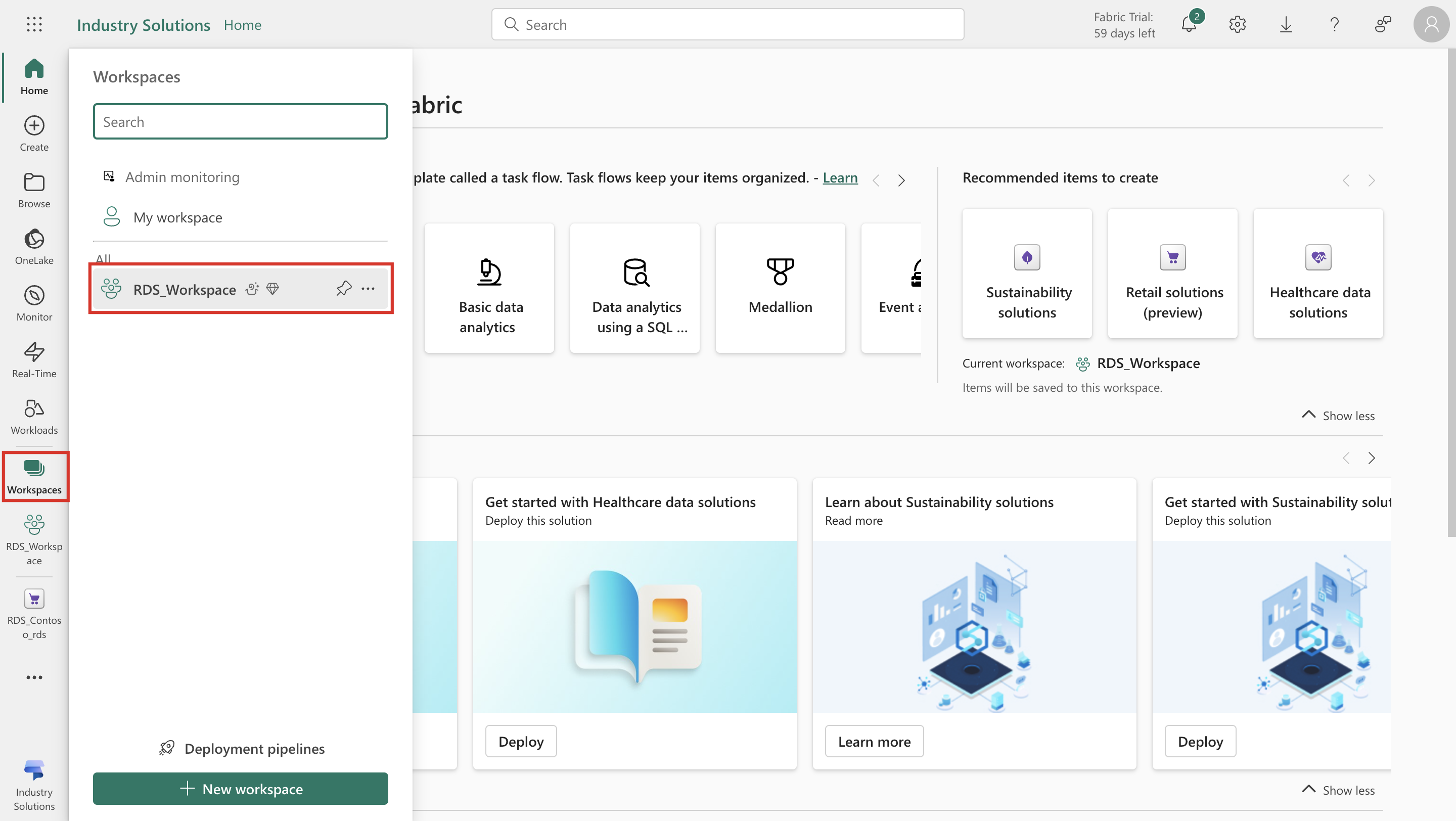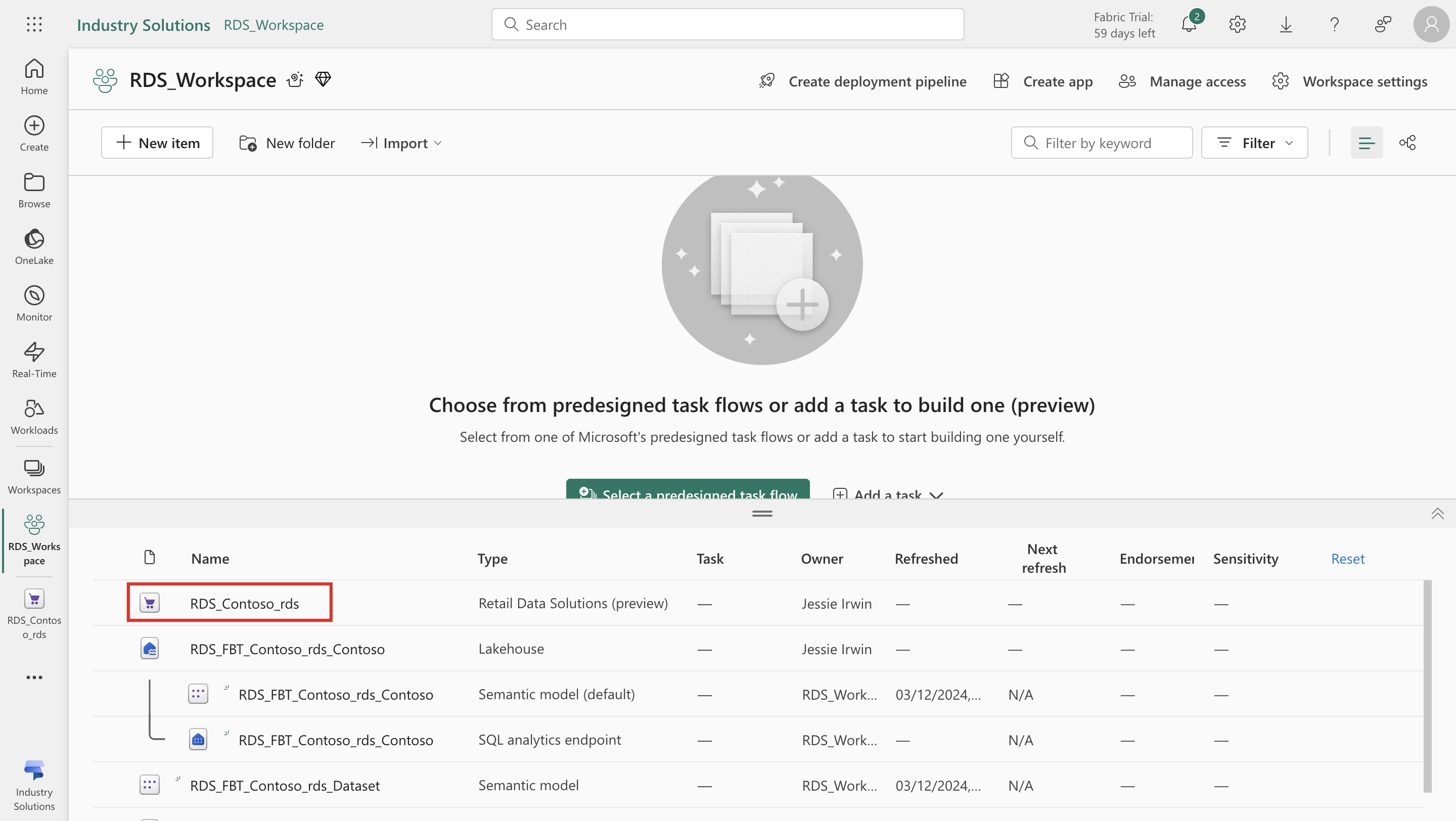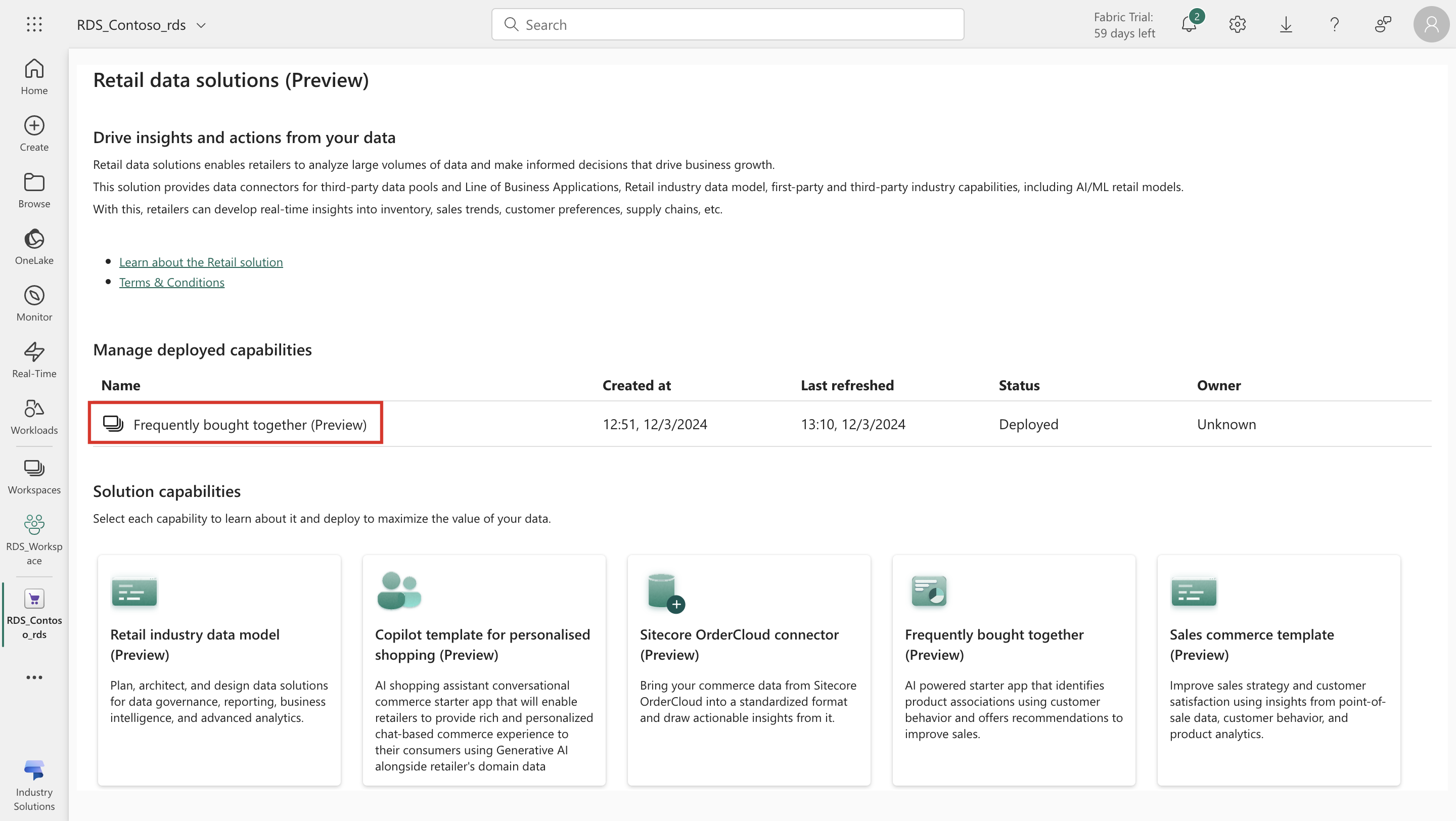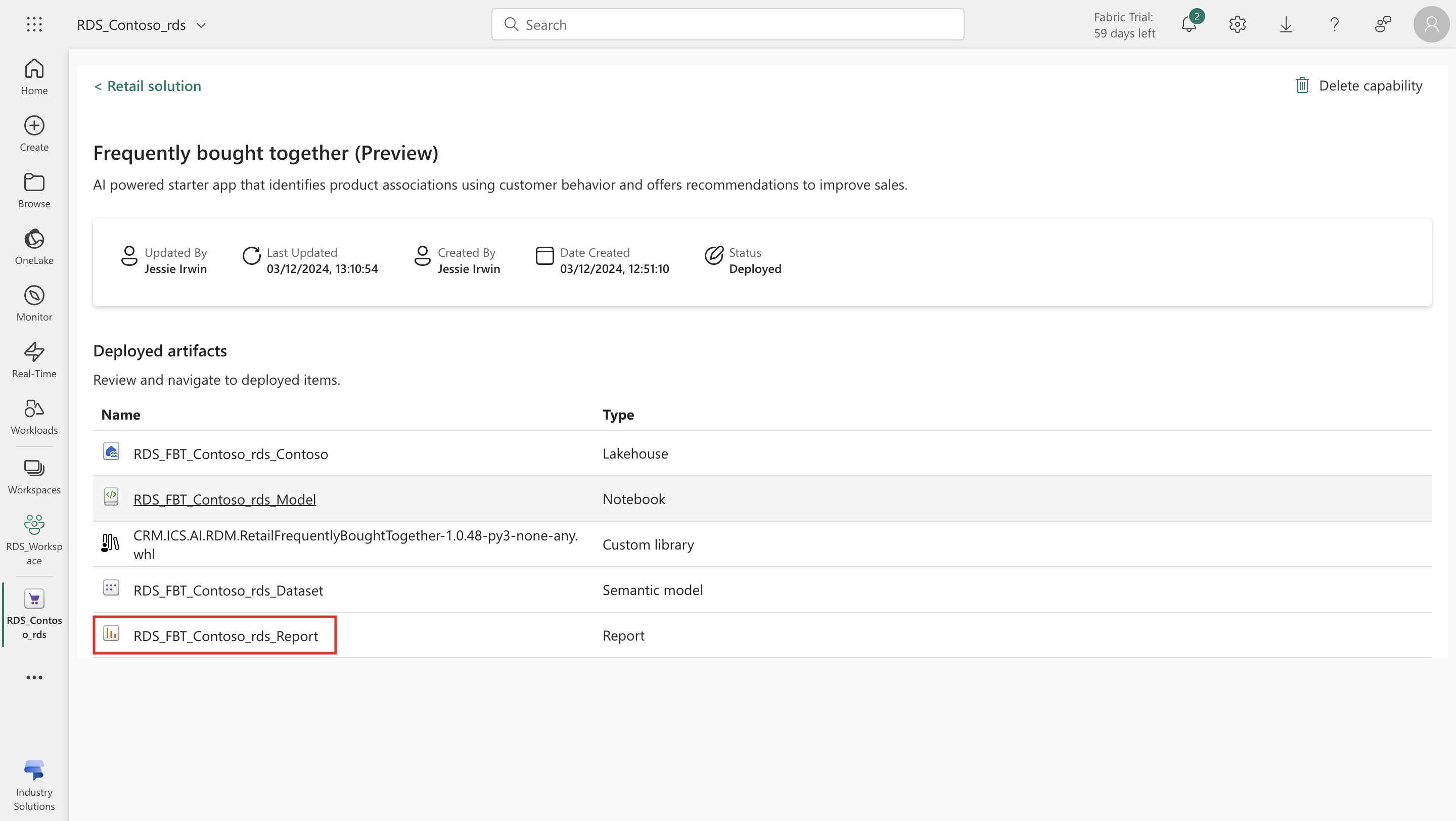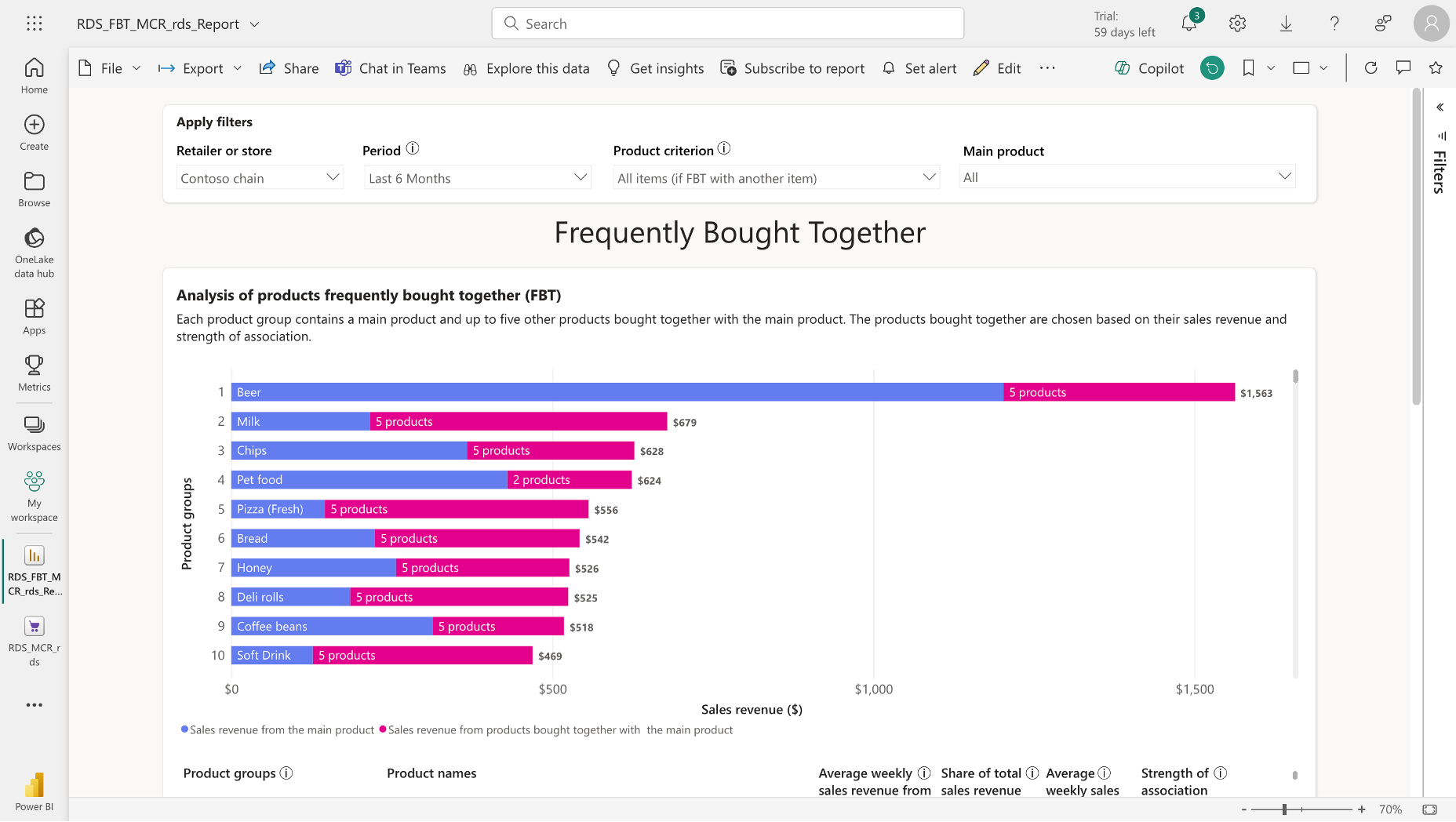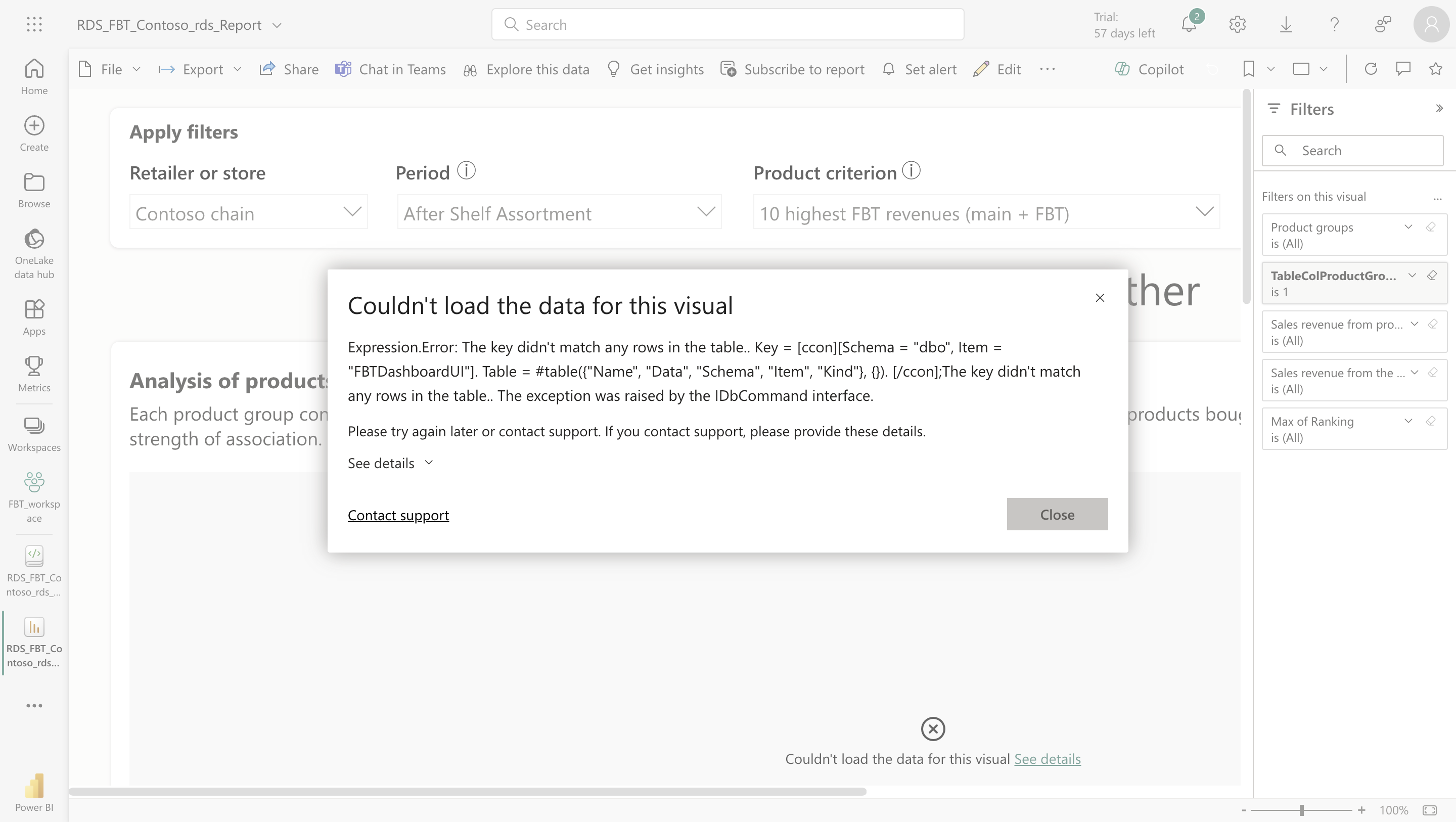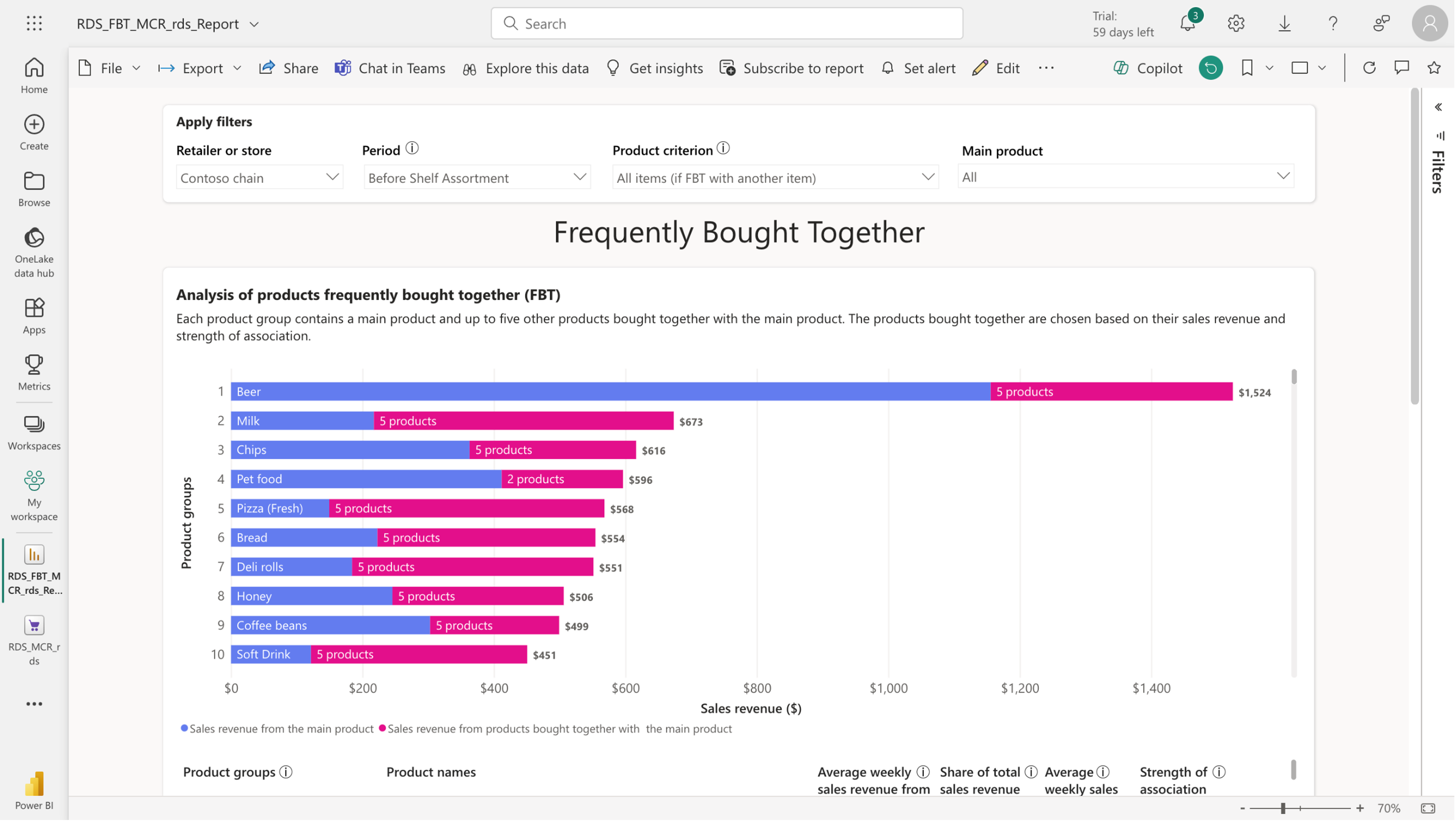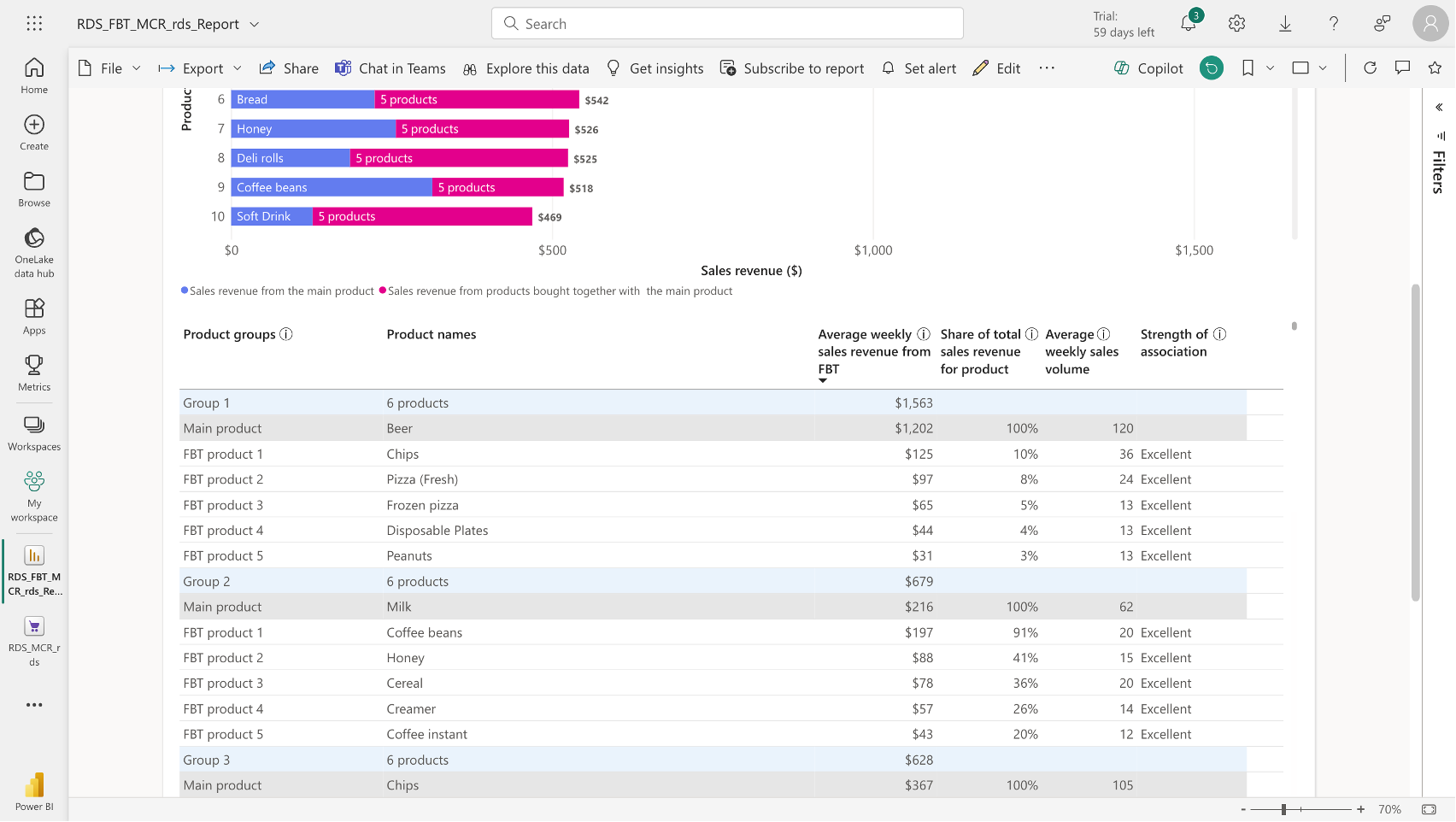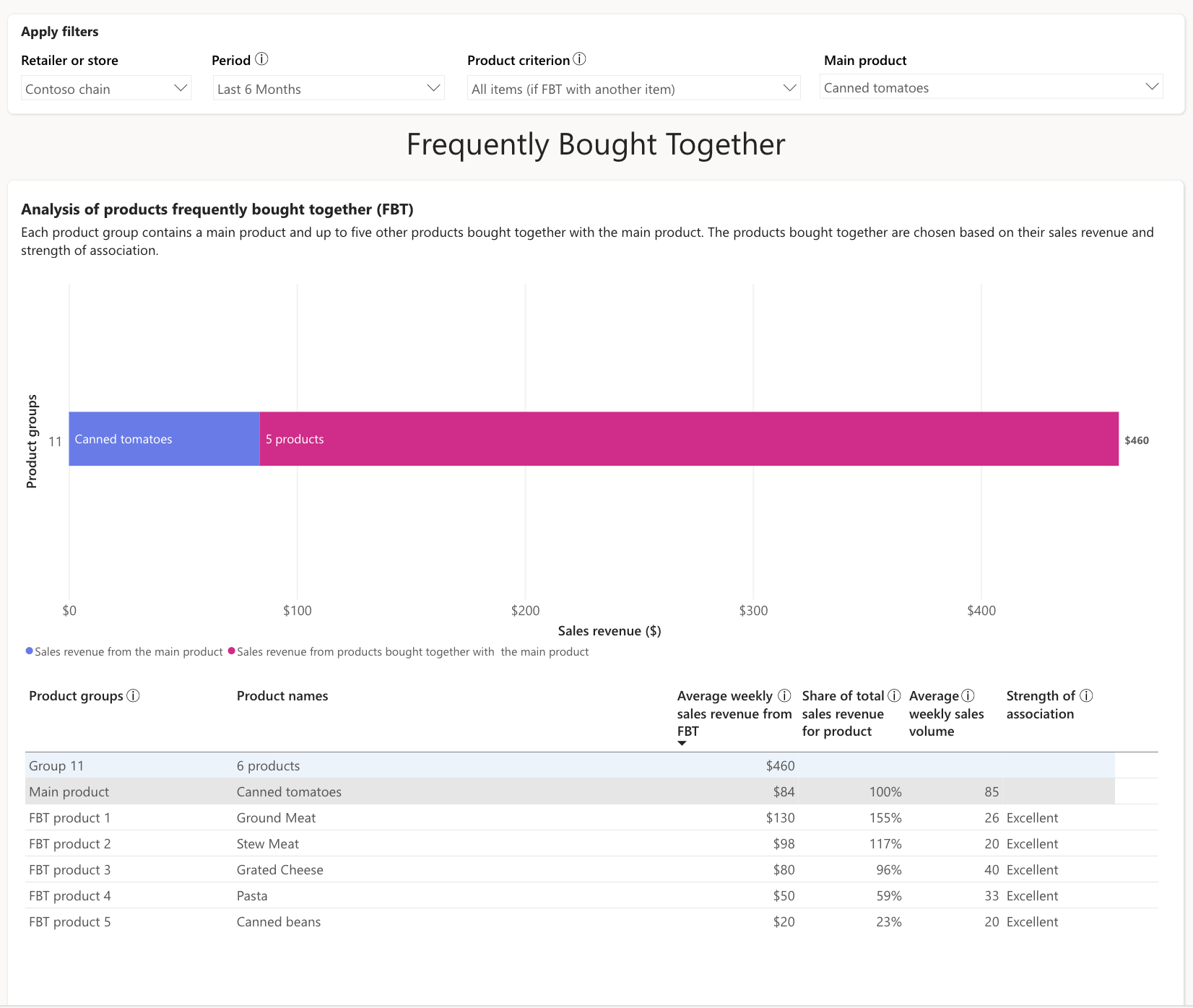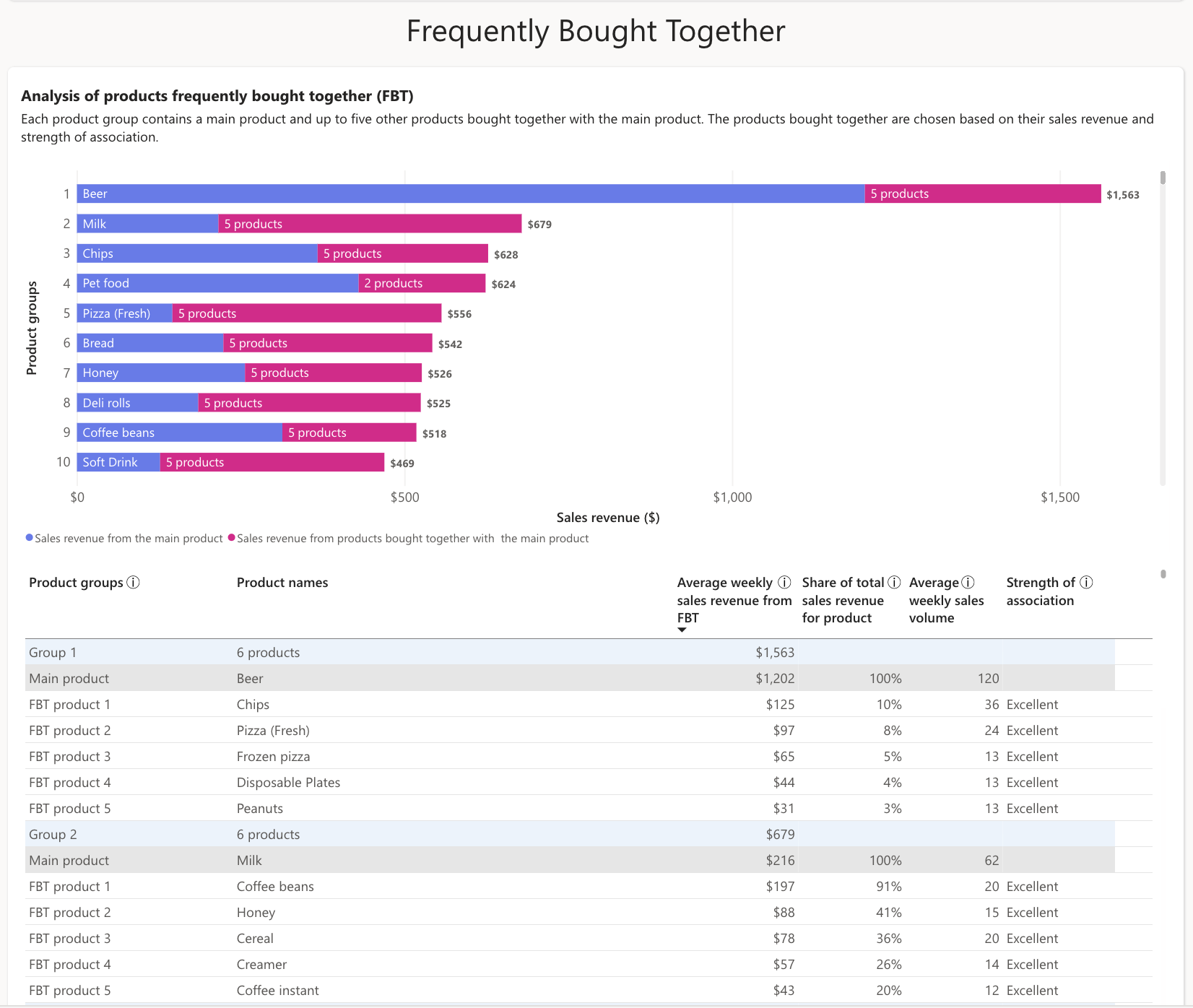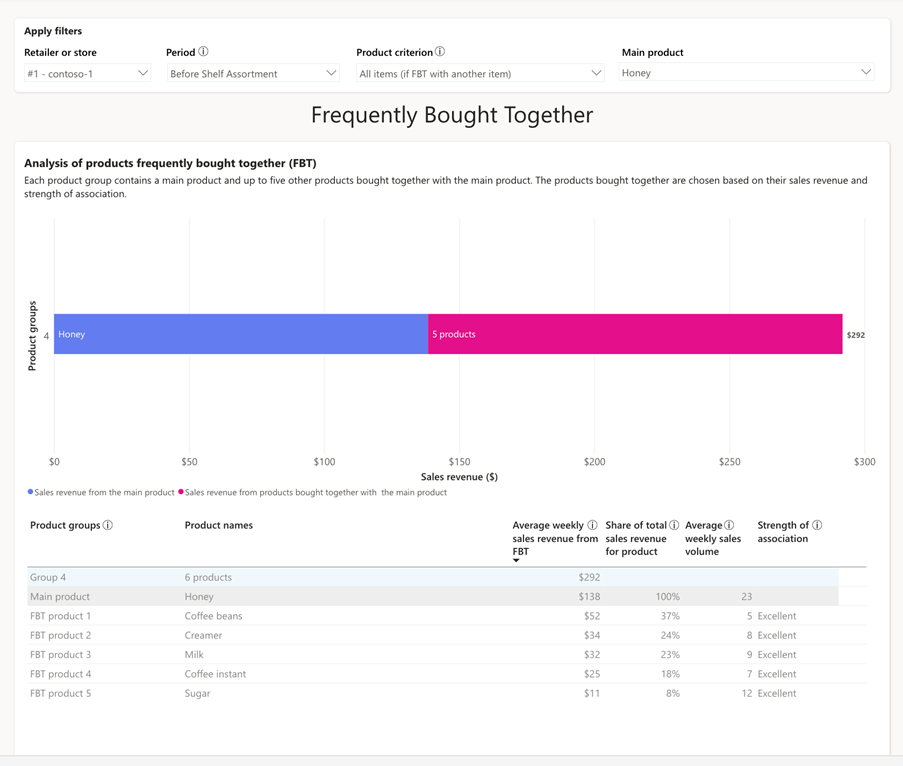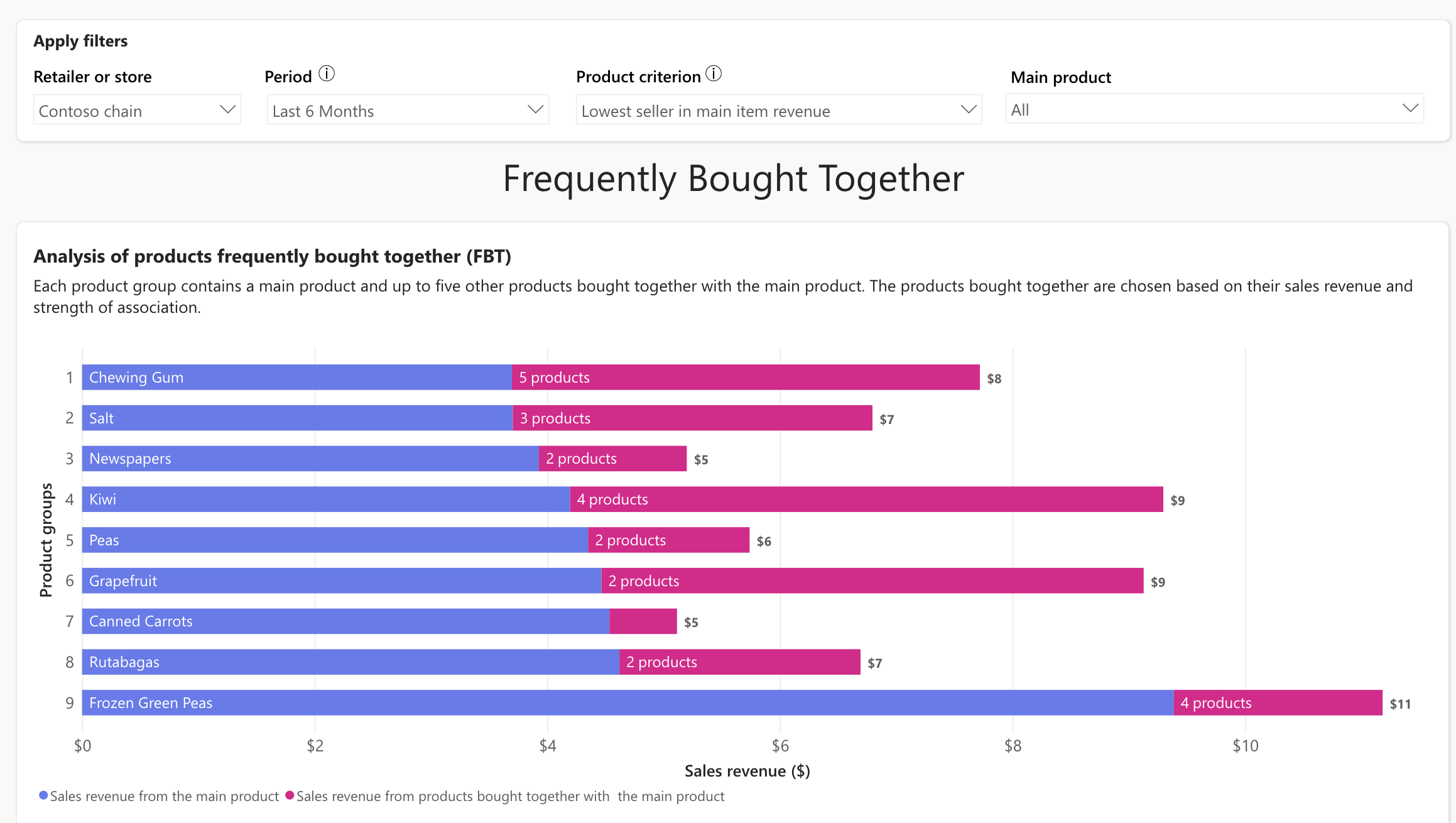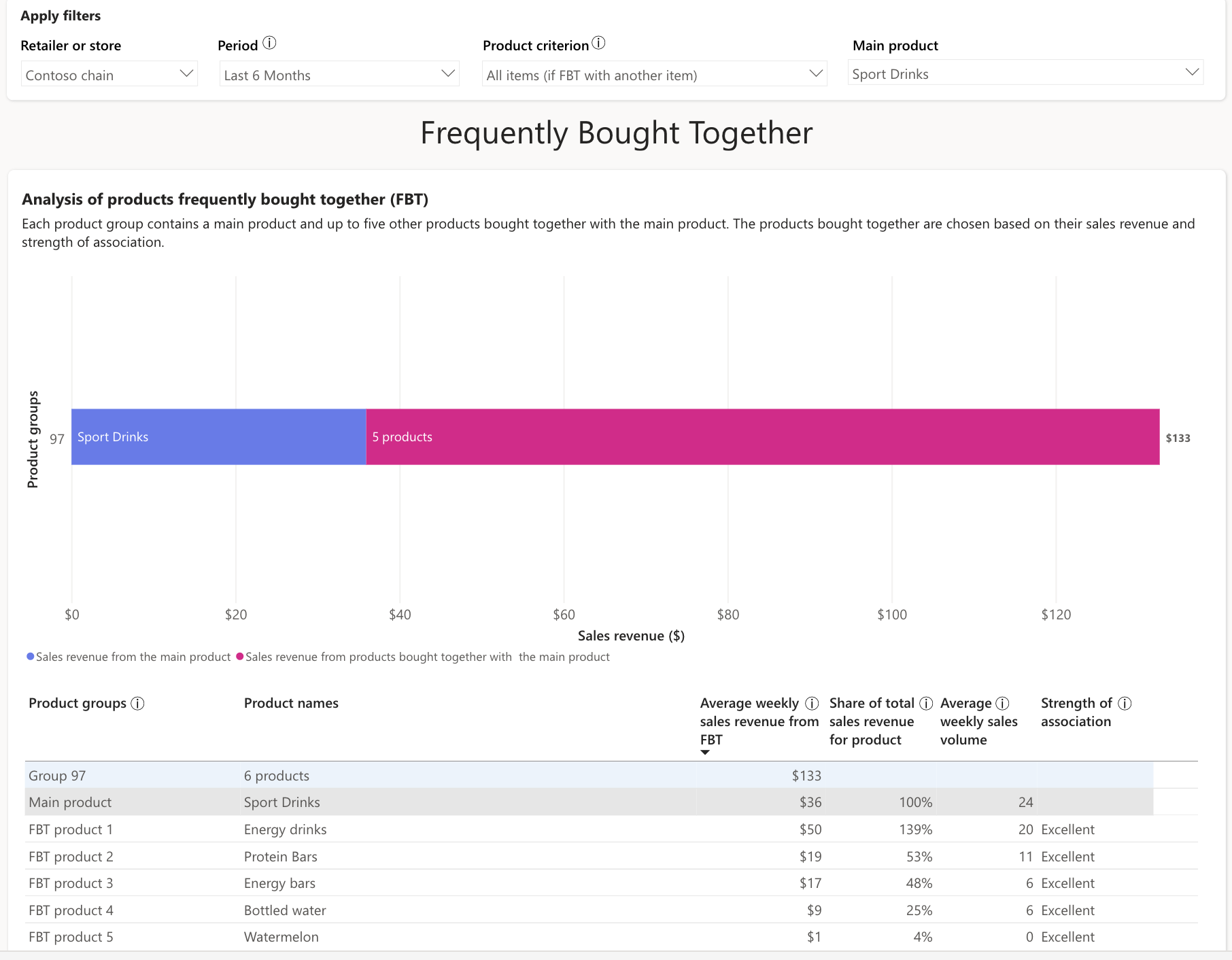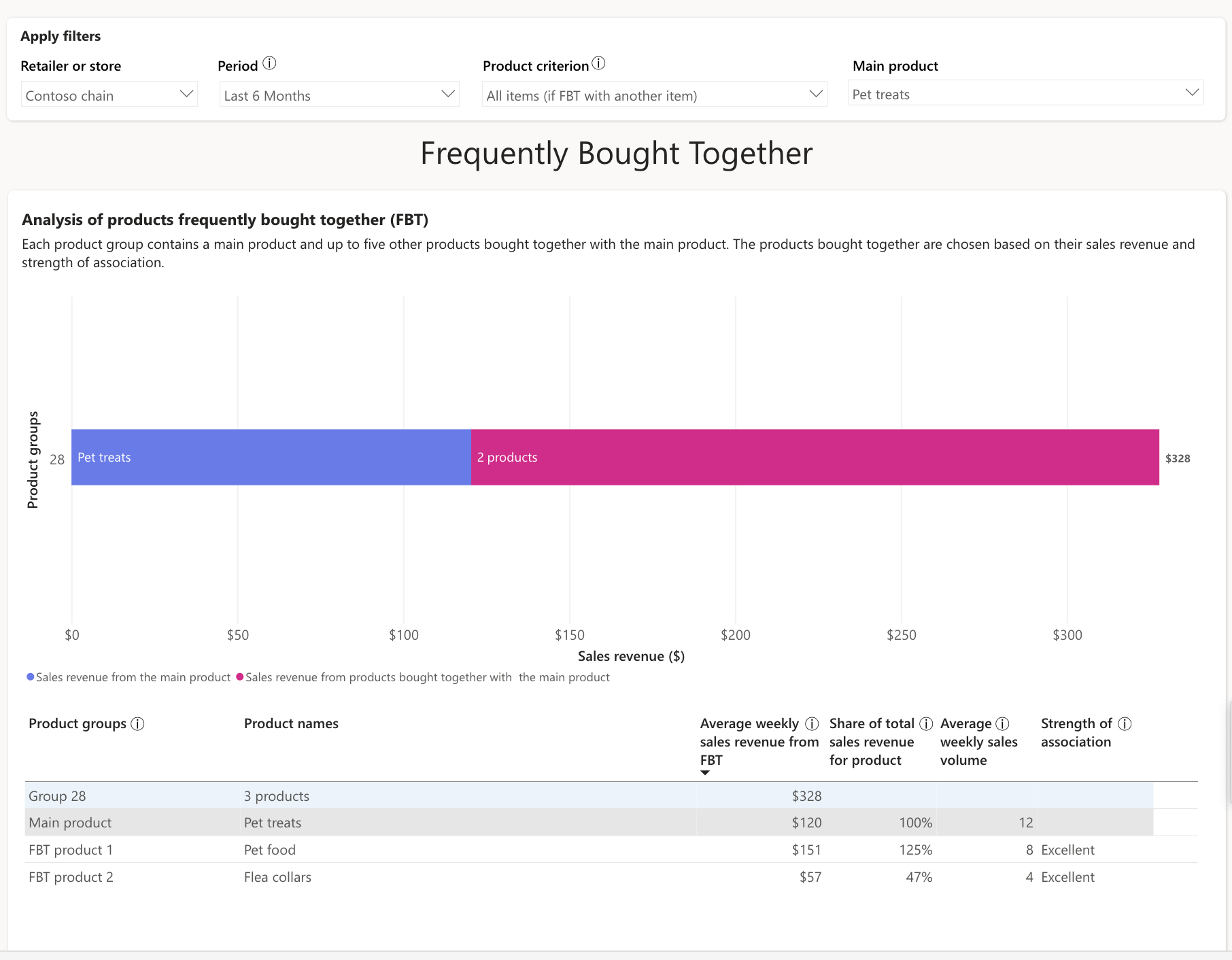Use Frequently bought together insights
In this exercise, you assume the persona of Megan Bowen and check the reports that the Frequently bought together model generated. You note the impactful insights that you want to share with the marketing team to help solve the challenges that Contoso Groceries contends with.
To access the Microsoft Power BI report that the Frequently bought together model generated, complete the following steps:
In a new Incognito or InPrivate browsing session, sign in to your Microsoft Power BI home page with the credentials of Megan Bowen.
Select RDS_Workspace.
Select Retail Data Manager, such as RDS_Contoso_rds.
Select Frequently bought together (Preview) under Manage deployed capabilities.
Open the Deployed artifacts panel and select the RDS_FBT_Contoso_rds_Report report.
The sample data is from Contoso Groceries.
Note
If the report doesn't show and an error shows instead, as shown in the following screenshot, wait for the configurations to come into effect.
Apply various filters so that you can define the POS data that the AI/ML Frequently bought together model analyzes.
In the Frequently bought together table, view each element of the group of products.
You can apply different filters in the Frequently bought together model to generate reports on the sales in Contoso. The following sections describe the impactful insights that you can share with the marketing team to help solve the challenges observed in Contoso Groceries.
Solution for the Meal planning challenge - Deliver personalized experiences with recipes
Recent advancements in the grocery sector, particularly in the realm of shoppable recipes and enhancing profitability, are noteworthy. Contoso Groceries positions itself at this crossroad. Their goal is to demonstrate that shoppable meal planning can simultaneously boost grocery store profitability while catering to customers' cravings for culinary inspiration and convenience.
Contoso wants to eliminate customer decision fatigue that's associated with finding meal inspiration and then adding ingredients to their carts.
By implementing the Frequently bought together feature to recommend products to their customers, Contoso Groceries helps their customers discover complete meal solutions or complementary ingredients based on purchasing patterns. For example, select the following filters:
Retailer or store - Contoso chain
Period - Last 6 months
Product criterion - All items
Main product - Canned tomatoes
From the insights, you can interpret that whenever customers purchase canned tomatoes, they also usually buy ground meat, stew meat, grated cheese, pasta, and canned beans. You can suggest a Meal kit for a high protein pasta recipe, which includes all ingredients and portions that are required for a specific recipe, such as canned tomatoes, ground meat, pasta, and grated cheese. It can also include the required portion of spices for the recipe, which adds to the value of the meal kit in terms of streamlined shopping experiences and ease of decision making.
Providing personalized meal kit suggestions that are smoothly integrated into the grocery shopping experience can boost customer satisfaction and loyalty. This strategy simplifies and improves the shopping experience for Contoso's customers. As customers add suggested missing recipe ingredients to their orders, it drives an increase in sales. Because it saves time, reduces stress, and helps with maintaining a balanced diet, customers are more likely to return to the store for future purchases.
Solution for the Basket size challenge - Cross-promotion and bundling to increase average basket value
By using the Frequently bought together feature, the retailer can identify cross-selling opportunities and recommend related products that complement the customer's original purchase.
By highlighting or placing complementary or frequently bought together items in near proximity, Contoso can encourage their customers to add more items to their cart that they might not consider otherwise, therefore increasing overall order value. Bundling related items together can increase their perceived value and encourage customers to add more to their shopping list. Additionally, offering discounts or incentives for bundled purchases further encourages customers to explore other products.
For example, by selecting the following filters, you observe that customers purchase coffee beans with milk.
Retailer or store - Contoso chain
Period - Last 6 months
Product criterion - All items
Main product - All
The Frequently bought together feature identified products that customers often purchase together with milk. As a result, Contoso can introduce the Morning Bliss Bundle, a combination that can include milk, coffee beans, honey, creamer, and cereal. With this bundle, Contoso can help their customers have a great start to their day.
Bundling items creates a perception of added value for customers. When you package complementary products together, customers are more likely to make a purchase. When you group products logically, it reinforces your brand’s image and messaging. It shows that you have thoughtfully curated a convenient shopping experience.
Solution for the Shelf space allocation challenge - Measure the impact of optimizing shelf space
By understanding how past marketing actions affect the sales of products that are frequently bought together, you can gain valuable insights into the effectiveness of promotions, store layouts, shelf layouts, or other marketing strategies. This optimization helps ensure that you allocate shelf space efficiently to products that contribute most to overall sales.
Consider a scenario where the store manager of Contoso Store 1 reorganizes the shelf layout to enhance the sales of coffee beans, particularly when customers bought them with honey. By applying the appropriate filters, you can assess the impact of this new shelf arrangement. First, select the following filters:
Retailer or store - contoso-1
Period - Before Shelf Assortment
Product criterion - All items
Main product - Honey
Next, select the following filters:
Retailer or store - contoso-1
Period - After Shelf Assortment
Product criterion - All items
Main product - Honey
Before shelf assortment, the sales percentage of coffee beans in relation to the lead item, honey, was 37%. After the shelf assortment, this figure rose to 49%, validating the store manager's strategy.
Tip
In the Configure model to generate insights exercise, you set up the Frequently bought together model with a time period filter. You can apply this same approach to analyze different promotional activities and seasonal buying patterns by adjusting the period filter in the notebook.
Solution for the Marketing effectiveness challenge - Optimize product catalog
By using the Frequently bought together feature, Contoso can optimize its product catalog to focus on items that drive the highest revenue and customer engagement. Analyzing the lowest revenue products can help the store decide which products to drop from the catalog. This data-driven approach allows the store to make informed decisions about future marketing initiatives to maximize sales and customer satisfaction.
For instance, under Product criterion, select the 10 lowest FBT revenues (main + FBT) option.
The list of products with lowest Frequently bought together revenue displays.
If you select Lowest seller in main item revenue, you can view the products that are least purchased in the selected time period.
You can change products' shelf placement or drop such products from the catalog to increase focus on high-selling products.
Solution for the Product navigation challenge - Enhance shopper navigation
Cluttered aisles hinder smooth shopping experiences. Overstocked shelves or poorly planned product placement can lead to crowded spaces, making it difficult for shoppers to move freely around the store to find products. Intentional product placement and carefully designed product displays are crucial to any retailer's merchandising strategy.
Insights from Frequently bought together can help retailers plan store layout and present curated products based on popular combinations. This approach streamlines the searching process for customers, which helps make it easier for them to make purchase decisions and enhances their overall shopping experience. When customers can save time navigating your retail store and can find what they need, they're more likely to become loyal shoppers.
Select the following filters to view the following group of items that are frequently bought together:
Retailer or store - Contoso chain
Period - Last 6 months
Product criterion - All items
Main product - Sports drinks
Contoso can create "discovery zones" with themed displays. They can group all sports and energy drinks along with sports and energy bars in one section. This change helps make it easier for fitness enthusiasts to locate these items. Similarly, Contoso can place juices, salads, vitamin supplements, fruits, bottled water, and plain yogurt in near proximity. This approach streamlines customer flow and enhances the shopping experience by making it more engaging and enjoyable.
Furthermore, Contoso can group merchandise by theme, occasion, or lifestyle. By guiding customers to relevant products and promotions, Contoso can use in-store navigation to help increase impulse purchases and cross-selling opportunities.
Solution for the Inventory management challenge - Optimize inventory management
By analyzing frequently bought together items, store managers can streamline inventory management processes. This approach is crucial for minimizing waste, maximizing profits, ensuring adequate stock levels, and implementing efficient replenishment strategies.
Store managers can categorize products based on their sales velocity, such as fast-moving, steady-selling, slow-moving, stagnant, or seasonal. This classification can guide decisions about product placement, pricing, and promotions. It's also crucial to monitor current events, holidays, special occasions, unpredictable demand patterns, and economic conditions for adjusting inventory management strategies as needed.
Consider a scenario where you were informed that the stock of a set of items, pet treats, is expiring soon. You select the following filters to view the items that are frequently bought together with the pet treats.
Retailer or store - Contoso chain
Period - Last 6 months
Product criterion - All items
Main product - Pet treats
As a result of the analysis, you can recommend that the store heavily discounts pet treats and that they should bundle the treats with pet food and flea collars. Bundling products that are near expiration with other frequently bought items is a strategic approach to reduce waste, encourage impulse buys, and boost sales.
